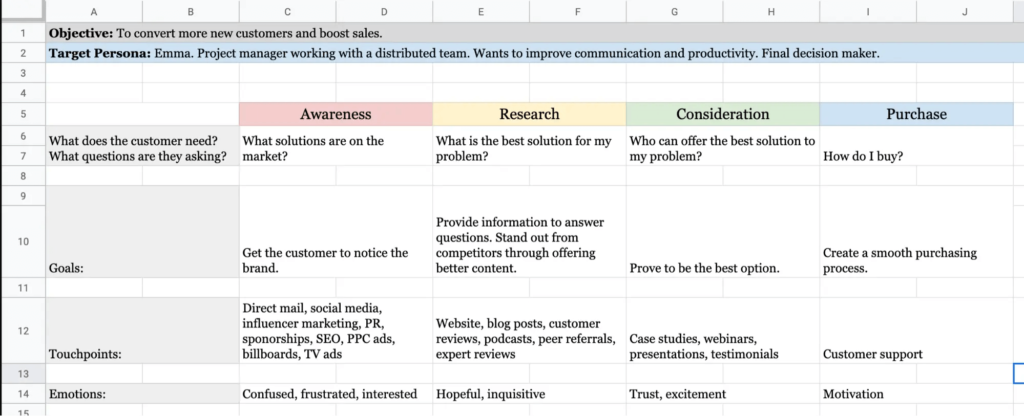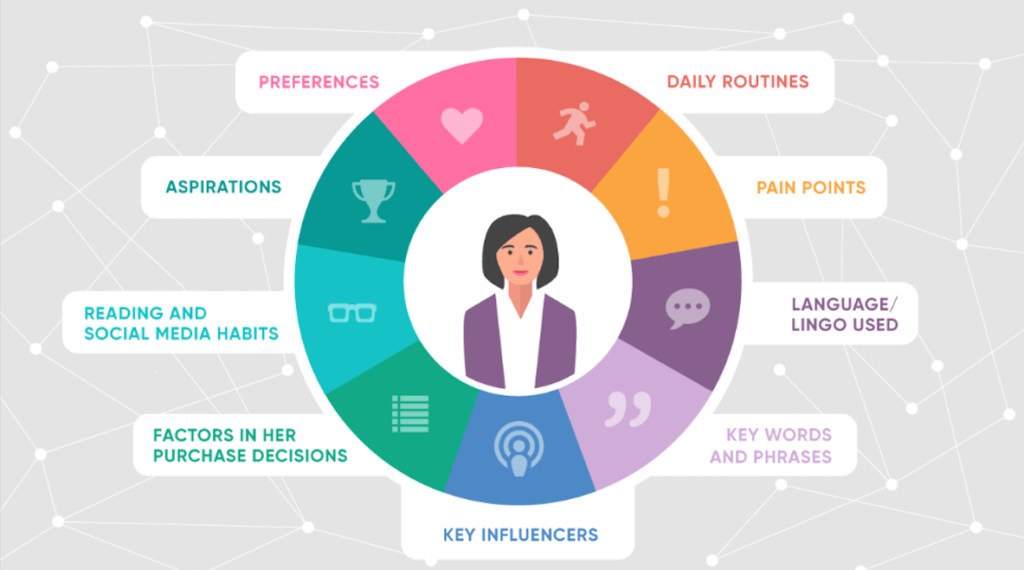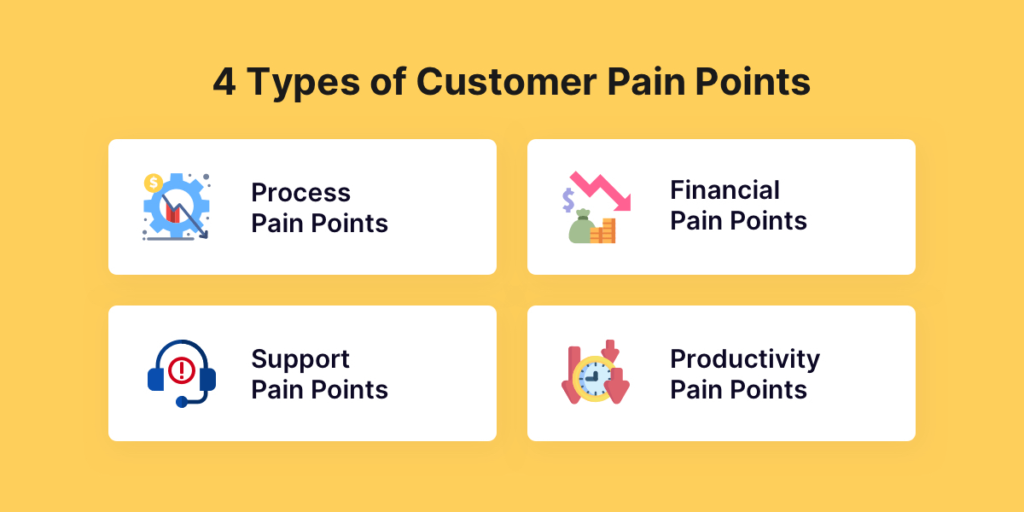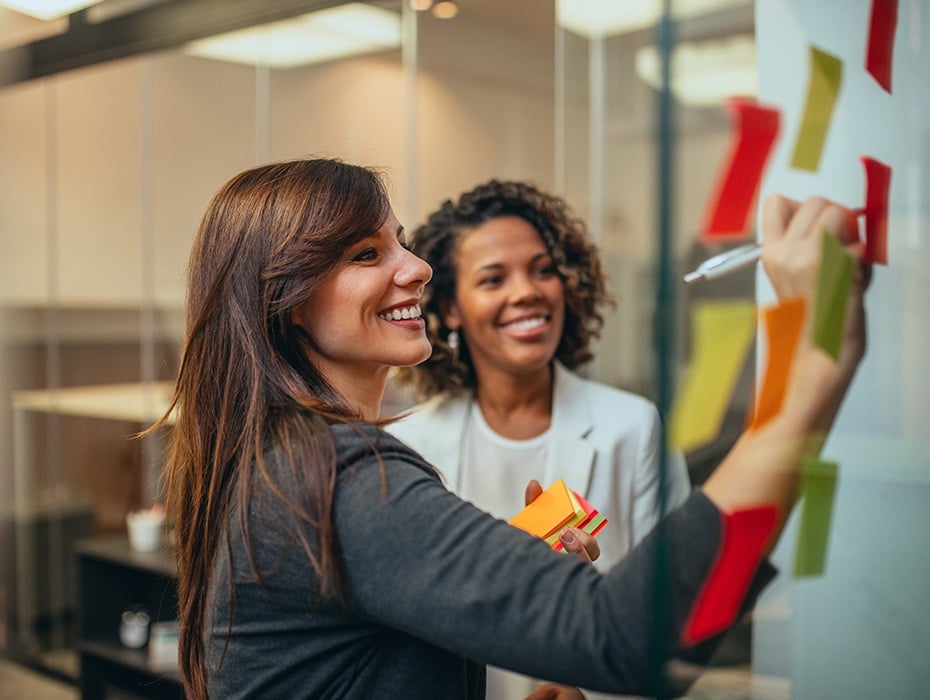Providing good customer support these days takes more than just offering products. It takes even more than answering queries and collecting feedback. More and more, customers are expecting personalized experiences with brands. And they want those experiences to be seamless across multiple touchpoints.
It’s not enough to guess what your customers want, either. You need to get into their heads in order to understand how they interact with your business. Customer journey mapping is a vital aspect of succeeding with your customer engagement and boosting customer satisfaction.
Customer journey mapping might seem like a lot of effort, but the results speak volumes. It’s been found to increase marketing ROI by 54% and upsell revenue by 56%.1 And these are statistics you can’t ignore if you want your business to succeed (while being efficient about it).
So what does this “customer journey” concept mean and how does it affect your business?
Keep reading to learn about:
- What is the “customer journey?”
- What is a customer journey map?
- Why is customer journey mapping so important?
- How can I create an effective journey map?
- How does customer journey mapping enable omnichannel marketing and customer service?
Want to create your own customer journey map? Download the free template to help you get started:
What is the “customer journey?”
A customer journey is the story of how somebody interacts with your business. Getting to grips with customer journeys is about understanding your users. It’s looking into how they behave while they interact with your business. And in which ways they are most likely to engage with your brand.
Once you understand this, the next step is to identify what you can do to improve their experience, so they keep coming back. This is where customer journey mapping comes in. If you can map out the rough stages of your customer journey, then you can dig into what your customers are looking for and how you can solve their pain points at each stage:
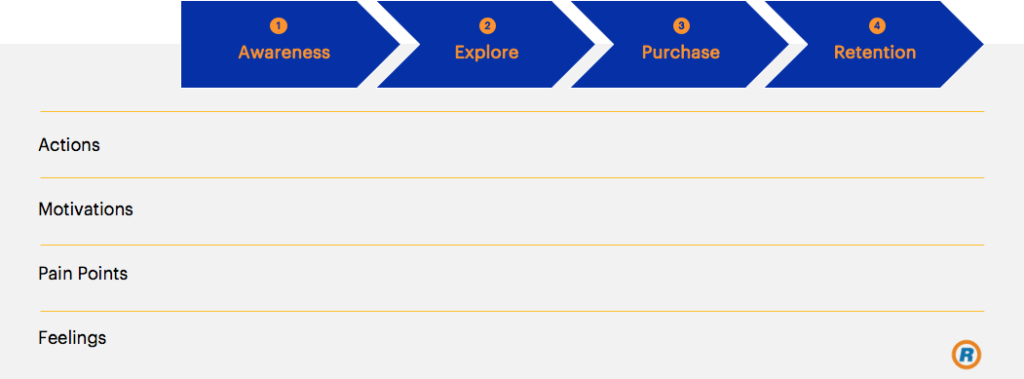
What is customer journey mapping?
Customer journey mapping is an exercise that should be considered by all businesses. It involves visually outlining the process a potential customer goes through. It tracks their journey from the first time they interact with you to their becoming a customer (hopefully).
That might be something as simple as signing up for a free trial. Or it could be as involved as making an extravagant purchase. The possibilities for journey mapping are endless.
Okay, what exactly is a customer journey map?
The best way to visualize how a customer interacts with a business is by mapping it. Most customer journey maps start as spreadsheets outlining key events and customer motivations. It’s important to also identify any areas of friction within the user’s experience.
This information is then combined into a comprehensive visual. That visual representation can describe an average user experience with your business.
Journey maps are a rough outline of the possible directions a customer might take. Every person is different, so it’s not possible to predict the exact steps they might take to convert. However, customer journey mapping can help you understand so much about the customer, including the customer’s needs and expectations of your brand.
It can tell the story of your customers’ experiences across all touchpoints. It can help with understanding their thought processes, behaviors, and needs. It can also help to identify their pain points. Arming yourself with this information will prevent anyone from slipping through the cracks.
Customer journey maps can help you make fundamental improvements to your business by:
- Helping you get to know your target audience
- Creating an inbound-first marketing model
- Adopting a customer-centric strategy
However, before you can start creating a customer journey map, you need to collect data. The process of creating an effective customer journey map is extensive, but valuable.
Customer journey maps give businesses a way of getting into a customer’s shoes. It helps to gain valuable insight and understanding regarding common customer pain points. They also aid in building empathy for customers. This can help brands understand what buyers want and how they feel:
Why is customer journey mapping important?
Customer journey maps will help you to run your business better. Rather than just guessing what your customer needs, you’ll know what they need. And, most importantly, you’ll also know how to give it to them.
A customer journey map breaks down their whole relationship with your business into individual phases. It allows you to visualize the many small decisions your customers make along the way.
You can then narrow your focus and deliver the right resources at the right time. This helps you convert prospects into customers more quickly and reduces the chances of you neglecting prospects or customers who need your help.
Only by understanding the entire customer journey, can you really know how to structure these touchpoints in the best way for your customers.
If this sounds intimidating or overwhelming, there are actually tools that can make this easier on you. For example, RingCentral’s Engage Digital platform is designed to help you keep track of your customers’ journeys with your company. Here’s a quick look at how it works:
It can log their interactions with you over every channel, from social media platforms to email to phone calls. Not only that, it also consolidates your conversations with any given person from all these channels. So, if someone messages you on Facebook and has also called you and emailed you and Tweeted you in the past, you’d be able to see that whole history in one place:
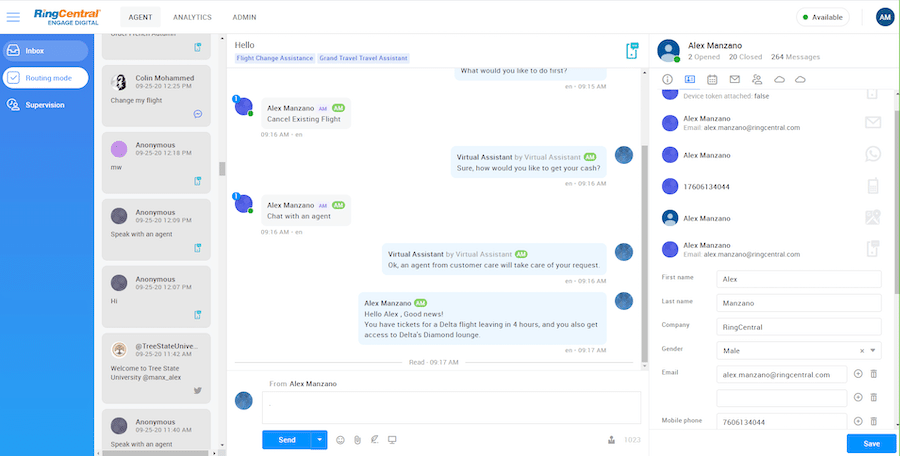
Customer journey mapping examples
There are lots of different types of journey mapping, depending on the type of business. Here are just a few types:
- Business to business (B2B) buyer journey maps
- Software as a service (SaaS) buyer journey maps
- Ecommerce experience maps
- In-store shopping buyer journey maps
- Online learning buyer journey maps
- Multichannel buyer journey map
You can download one of our handy free journey map templates to help you create your own custom journey map. These will help you speed up the process a bit since you’re not starting from scratch.
How to create an effective journey map
Customer journeys aren’t always linear. Buyers often take a back and forth, cyclical, multi-channel journey. The mapping can be hard to visualize.
For this reason, there are a variety of ways of representing the journey. From post-it notes on a boardroom wall, to Excel spreadsheets, to infographics. The most important thing is that the map makes sense to those who’ll be using it:
You’ll need to look at your objectives. What do you want to accomplish from the journey mapping process, and who is most likely to complete that task? If this is the first customer journey map you’re creating, just focus on one buyer persona for now.
Establish your target persona and some key details about who they are. Having this info clearly visible throughout the process will help you stay focused.
There are also a few elements to focus on in order to create an effective journey map. We will now go into these in more detail.
1. Work out your overall objectives
It’s all well and good to decide you want to map your customer journey, but do you know why you are doing it?
Of course, we can give you many reasons why it’s something you should be doing for your business. But what are you hoping to accomplish by mapping out this customer journey? What are the individual steps and goals you want the customer to complete? This will inform your next steps, like knowing which resources you need to share with the customer at each point.
Start by setting clear goals. Then look at how these will translate into your larger business objectives. Knowing objectives can help you identify potential problems in your current customer journey and decide on the future state of the journey that you want to shoot for.
Get the whole team together for a brainstorming session, and make sure you have a good communication platform that connects your whole team. The RingCentral app, for example, has not only messaging and video conferencing, but also a phone system that can connect remote and global teams. With video conferencing capabilities, this is the perfect option for your objectives brainstorming session.
2. Understand the customer lifecycle
The customer lifecycle definitely varies depending on business and industry. But it commonly follows these steps:
- Discovering the brand
- Researching the brand and its solutions
- Consideration and comparison
- Making a purchase
- Referring other customers to you (yay!)
If you can prioritize making sure your customer is satisfied from the beginning (before they actually make a purchase), you increase the chances of making this a long-term, valuable relationship for you.
You’ve probably heard that customer retention is super important. And it’s for a few reasons. Customers who are retained after purchase will continue to show support for your business and be your biggest cheerleaders to their friends and colleagues—it’s free advertising for you. They may share positive feedback about you online on their own social networks or on review sites. That’s even more free advertising for your business.
That’s the benefit of building relationships with customers. So, make sure you’re using the right tools to help you engage with your customers. Support, engage, inspire, and understand your customers with a good customer support tool or omnichannel contact center.
For example, a cloud contact center like the one we mentioned above can help you nurture these relationships with customers (and potential customers), no matter what platform they use—and at any point in the customer lifecycle.
Understanding the phases of the customer journey and what happens at each, sets the framework as you create your customer journey maps. What should happen at each stage? What experience do you want the customer to have? What experience are they currently having?
And don’t forge to make it easy for your team to communicate and share this information. Knowing your customer reactions and the status of an important account in real time is a significant step in building out your customer journey maps. If a customer is complaining about a new feature—and it turns out other customers have been saying the same thing—is your customer support team able to communicate that to your product team?
Beyond email, how else is your team able to communicate with each other in real time? (Hint: team messaging, video conferencing, and even a good old-fashioned phone call are all acceptable alternatives depending on the situation.) Make sure you and your team are equipped with an easy way to reach out to each other quickly if something urgent comes up. For instance, having a desktop and mobile app that lets you message, video conference, and call each other—all in one place—might be something to look into:
3. Map out touchpoints
A touchpoint is any place where your customer engages with your brand. This could be through your website, via email, social media, third-party sites, or over the phone.
There might be a number of different touchpoints between customers and your brand. Not all of them will be relevant to every customer journey map but all need consideration.
Different touchpoints typically go with different phases of the customer journey. For example, social media interactions are more prevalent during the awareness stage. Customer reviews might not be looked at until the customer is in the consideration phase.
An important part of mapping touchpoints is making sure that they are all seamlessly connected. A unified communications platform will help to unify all channels of communication, removing the need for multiple tools. RingCentral’s unified communications as a service (UCaaS) solution is a game-changer for staying on top of all your communications throughout the customer journey.
4. Start to build a customer persona
Creating customer personas is the very first step in getting to know your customer. It is a fictional representation of your ideal customer, including demographics and psychographics.
Start by outlining all your different types of customers, who they are, and what they might be looking for:
There are many questions that you could ask in order to build a customer persona. Here are some ideas you could consider:
- What are your customers’ responsibilities?
- Where are they located?
- What hobbies, activities, or organizations do they take part in?
- Are they the decision-maker for buying your product? If not, how do they connect with the decision-maker?
- What challenges are they facing?
- What solutions have they already tried to solve those challenges? Where did those solutions come up short?
- What are they interested in learning about from you?
- What are the most important factors when they’re deciding to make a purchase?
You’ll generate a few customer personas, and you can’t target them all with one customer journey map. Each persona will likely have a different customer journey. Build case studies based on the information you already have, and then expand from there.
5. Apply the customer journey map examples and understand their pain points
Each persona will have a different journey depending on a few different metrics, such as:
- Who they are
- Where they are from
- Their budget constraints
- Problems they’re facing
- Solutions they’ve tried
You need to identify which persona is relevant to each customer journey map you’re creating.
It’s important to recognize pain points in the process that might be causing friction. For example, when customers have to take too many actions to achieve their goals:
Reducing the number of steps a customer needs to take can pay off in higher conversion rates.
The customer’s perspective can’t be assumed or predicted based on your own internal perspective. A customer journey is very specific to the physical experiences your customers have. Thus, the best way to understand the journeys of your customers is by asking them.
Another idea is to ask your support team members. They interact with customers daily. They respond to problems, answer questions, and collect feedback. Encourage your team to collaborate and share their information. Make team collaboration easier and more personal with HD audio and video using RingCentral Office®.
6. Follow the customer journey map yourself
Your customer service team and your customers should have some decent insights. But nothing beats the first-hand perspective.
Firstly, implement changes to your map based on the information you’ve collected. Then it’s time to follow the map yourself.
Pretend you’re a customer interested in your products or services. Follow the progression of the touchpoints to move through the four life cycle stages.
At each point, analyze if you feel you have enough information or not. Do you have any questions that haven’t been answered, or do you feel like something is missing? There might still be some gaps that haven’t been identified yet.
It’s possible that you might find you feel too close to the customer journey to make a call. That is fine. You will just need to ask someone outside your circle to follow the process. Either way, this step is really important to seeing if you have improved processes at all.
How does customer journey mapping enable omnichannel marketing and customer service?
Today’s consumers want a highly customized and personalized experience. More and more, customers expect companies to know and remember who they are and what they’re looking for. This is true even across multiple customer touchpoints. They want you to be able to pick up a conversation where they left off, without them having to repeat or clarify their needs.
One of the biggest perks of creating a customer journey map is that it can help you with both your marketing and customer service efforts. (Especially important if you’re providing omnichannel customer service or running omnichannel marketing campaigns.)
How does customer journey mapping play a crucial role in this process? Well, for marketing, it allows marketers to target one prospect across multiple touchpoints. For example, a customer who browses a product on a website can be targeted with a social media ad later on.
On the other hand, a customer experience department may also have a dedicated team to monitor VIP customers. They can spot pain points before they arise, and maintain a strong relationship.
Pro-tip: For more complicated or VIP customer accounts, it might be a good idea to have a team group chat that keeps everyone who’s responsible for that account up to date on how that customer is doing.
If you’re doing omnichannel marketing, it makes sense to back it up by omnichannel customer service. As we mentioned above, this is where the customer can receive customer support across any channel, like email, live chat, and social media.
Regardless of whether you’re trying to improve your marketing or customer service (or both), customer journey mapping—and using the right customer service software can help you better understand the customer experience.
So what’s next as you build out your customer journey map?
Once you’ve mapped the different scenarios and built personas, you’re making great progress!
But mapping out the customer journey is just the first step. Once you create your map, you need to apply it to your individual situation. It should fit with your business model, content, and deliverables. That way, you can create a better customer experience for your audience.
You can then make valuable use of the knowledge and insights you’ve amassed from your customer journey maps. Apply them to crafting engaging marketing campaigns, high-converting landing pages, and more.
Customer journey maps require consistent reflection and revision. Come back to your customer journey map every few months to see if it’s still relevant.
Grow your customer journey maps and make them more detailed over time. That way, you will keep building stronger connections with your audience.
1, 2salesdriver.io/2019/09/27/7-power-stats-on-why-the-customer-journey-matters-in-2019
Originally published Nov 23, 2020, updated Jun 24, 2024



